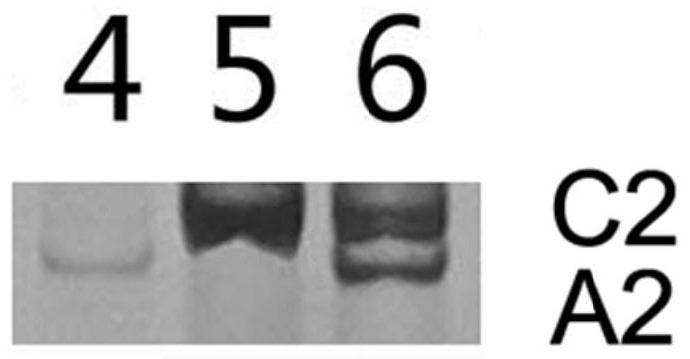Molecular markers for identification of a02 and c02 chromosome segregation in hybrids between Chinese cabbage and Ethiopian mustard and their progeny
A technology of molecular markers and chromosomes, applied in the field of genetic breeding, can solve time-consuming and labor-intensive problems, achieve simple and fast cost, expand genetic resources, and reduce material costs
- Summary
- Abstract
- Description
- Claims
- Application Information
AI Technical Summary
Problems solved by technology
Method used
Image
Examples
Embodiment 1
[0042] CO2B-R: 5'-GCCATTTTGAACCATGAACC-3'.
[0043] 1.3 PCR amplification. to be detected F
[0044] 1.4 The above PCR products were detected by polyacrylamide gel electrophoresis. Configure 8% polypropylene gel, 180 volt electrophoresis 1.5
[0045] 1.5 Take out the above-mentioned polyacrylamide gel, silver staining, see Figure 1.
[0048] The F
Embodiment 2
[0052] 1.1 Extract the genomic DNA of the plants to be tested and their parents.
[0054] 1.3 PCR amplification. Taking the plants to be detected and their parental DNAs as templates, PCR amplification reactions were carried out with the above primers. opposite
[0055] 1.4 The above PCR products were detected by polyacrylamide gel electrophoresis. Configure 8% polypropylene gel, 180 volt electrophoresis for 2 hours
[0056] 1.5 Take out the above-mentioned polyacrylamide gel, silver staining, see Figure 4.
[0059] Whole-genome illumina sequencing was carried out to the No. 3 individual plant that was identified by molecular markers, and the sequencing depth was 10 ×;
PUM
 Login to View More
Login to View More Abstract
Description
Claims
Application Information
 Login to View More
Login to View More - R&D
- Intellectual Property
- Life Sciences
- Materials
- Tech Scout
- Unparalleled Data Quality
- Higher Quality Content
- 60% Fewer Hallucinations
Browse by: Latest US Patents, China's latest patents, Technical Efficacy Thesaurus, Application Domain, Technology Topic, Popular Technical Reports.
© 2025 PatSnap. All rights reserved.Legal|Privacy policy|Modern Slavery Act Transparency Statement|Sitemap|About US| Contact US: help@patsnap.com



